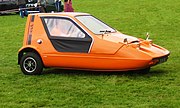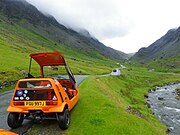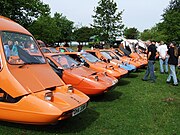Bond Bug
| Bond Bug | |
|---|---|
 | |
| Overview | |
| Manufacturer | Bond Cars Ltd /Reliant |
| Production | 1970–74 2,270 made[1] |
| Assembly |
|
| Designer | Tom Karen (Ogle Design) |
| Body and chassis | |
| Class | Microcar |
| Body style | canopy door coupé |
| Powertrain | |
| Engine | Reliant 700 cc, later 750 cc |
| Transmission | 4-speed |
| Dimensions | |
| Wheelbase | 6 ft 5 in (1,956 mm)[3] |
| Length | 9 ft 2 in (2,794 mm)[3] |
| Width | 4 ft 7 in (1,397 mm)[3] |
| Height | 4 ft 2 in (1,270 mm)[3] |
| Kerb weight | 868 lb (394 kg) |
| Chronology | |
| Predecessor | Bond 875 |
The Bond Bug is a small British two-seat, three-wheeled automobile which was built from 1970 to 1974, initially by Bond Cars Ltd, but subsequently by the Reliant Motor Company. It is a wedge-shaped microcar, with a lift-up canopy and side screens instead of conventional doors.
Contents
1 History
1.1 Founding and early years
1.2 Launch and production run
2 Popular culture
3 Gallery
4 See also
5 References
6 External links
History
Founding and early years
Following the purchase of Bond Cars Ltd., Reliant commissioned Tom Karen of Ogle Design to design a fun car. The Bond Bug was based on chief engineer John Crosthwaite's newly designed chassis[4][5] and some Reliant Regal running gear. The original concept was explored by chopping down a production Regal vehicle, the rear of the car being shortened to end over the rear axle.[citation needed]
The engine is the front-mounted 700 cc (later uprated to 750 cc) Reliant light-alloy four-cylinder unit, developed from the Austin 7, and which protruded into the passenger cabin. At launch 29 bhp (22 kW; 29 PS) was claimed for the less expensive 700 and 700E models. The more upmarket 700ES incorporates a redesigned cylinder head which permitted the compression ratio to be increased from 7.35:1 to 8.4:1.[6] This provided a power increase to 31 bhp (23 kW; 31 PS) as well as improved torque for the then range-topping 700ES.[6]
The Bond Bug 700ES also offers more ergonomic seats as well as more padding over the engine cowl, twin mudflaps, an ashtray, a rubber front bumper and a spare wheel.[6]
Launch and production run
The car enjoyed an upbeat launch, at which Reliant's Ray Wiggin stated: "The fact it has three wheels is quite incidental. It's a new form of transport. So now, in fact, we think it's going to appeal to a much wider section of the market than we originally envisaged."[6]

Bond Bug (interior), with the original bright orange tangerine colour on exterior
The Bug was available in a bright orange tangerine colour, although six white Bugs were produced for a Rothmans cigarette promotion – one of which was also used in an advertisement for Cape Fruit. Only three Rothmans bugs are known to exist.
The car's fame was helped by a distinctive Corgi Toys die-cast toy car. Although it had a fairly short production run (1970–74), it has a dedicated following today.[when?]
In contrast to the image of three-wheeled Reliants as being slow, the Bond Bug was capable of 76 mph (122 km/h), in excess of the UK national speed limit (70 mph/112.6 km/h), and comparable to small saloon cars such as the basic 850 cc Mini (72 mph/116 km/h) and the Hillman Imp (80 mph/128 km/h). However, it could not match the speed of the Mini Cooper S (96 mph/154 km/h) or larger saloons such as the Ford Cortina Mark III (104 mph/167 km/h in the highest-powered variant), or even aging models of two-seater sports cars, such as the MG MGB (103 mph/165.7 km/h) or the Lotus Seven, where by 1970 even the lowest-powered version of the S4 could reach 108 mph/173.8 km/h.[7][8]
The Bond Bug was sold as being fun to drive, with the low seating position giving a similar exaggerated impression of speed as in a go-kart, while the actual speed was similar to that reached by high performance cars only a few years earlier (indeed, earlier versions of the Lotus 7 had a top speed of 76 mph/122 km/h right up until 1968, and their trim level, e.g. side curtains instead of windows, was also similar).[7]
The Bug was, however, no cheaper than more practical cars. It cost £629, while a basic 850 cc Mini, a four-seater much faster round corners but with considerably inferior acceleration, cost £620. Also, while a basic Lotus Seven (with much faster acceleration and good cornering) cost £945 in 1970,[8] it was also available as a complete knocked down kit much more cheaply, partly because of more favourable tax treatment.[citation needed]
Popular culture
Tom Karen oversaw the design and production of Luke Skywalker's landspeeder from Star Wars (1977): one of the models was built upon the chassis of a Bond Bug – the wheels hidden by mirrors angled at 45° to the ground.
The Wheeler Dealers television programme purchased and restored a Bond Bug 700ES and, after completion, sold it on to make a profit. Since then, the Bug has been on display at the 2011 NEC Classic Car Show in Birmingham, where Wheeler Dealers presenters Mike Brewer, Edd China and mechanic/technical assistant Paul Brackley were reunited and signed the Bug.
A Bond Bug was featured in some of the earlier episodes of Hollyoaks as a vehicle belonging to Jambo Bolton.
The car has also appeared in the video for the Robbie Williams song "Millennium", and in the 118 advertisements.[9]
In series 2 of the television programme The Grand Tour, presenters Richard Hammond and James May go on to build an amphibious vehicle by combining a Bond Bug with the engine of a personal water craft, nicknaming it the "Pond Bug". Competing on Coniston Water during Coniston Power Boat Records Week, the third presenter, Jeremy Clarkson, operates the "Pond Bug" and achieves an average of 47.81 mph (76.94 km/h), setting a new UK record.[10]
Gallery
.mw-parser-output .mod-gallery{display:table}.mw-parser-output .mod-gallery-default{background:transparent;margin-top:0.5em}.mw-parser-output .mod-gallery-center{margin-left:auto;margin-right:auto}.mw-parser-output .mod-gallery-left{float:left}.mw-parser-output .mod-gallery-right{float:right}.mw-parser-output .mod-gallery-none{float:none}.mw-parser-output .mod-gallery-collapsible{width:100%}.mw-parser-output .mod-gallery .title{display:table-row}.mw-parser-output .mod-gallery .title>div{display:table-cell;text-align:center;font-weight:bold}.mw-parser-output .mod-gallery .main{display:table-row}.mw-parser-output .mod-gallery .main>div{display:table-cell}.mw-parser-output .mod-gallery .caption{display:table-row;vertical-align:top}.mw-parser-output .mod-gallery .caption>div{display:table-cell;display:block;font-size:94%;padding:0}.mw-parser-output .mod-gallery .footer{display:table-row}.mw-parser-output .mod-gallery .footer>div{display:table-cell;text-align:right;font-size:80%;line-height:1em}.mw-parser-output .mod-gallery .gallerybox .thumb img{background:none}.mw-parser-output .mod-gallery .bordered-images img{border:solid #eee 1px}

Bond Bug side view with the canopy closed

Bond Bug with canopy open and Honister Pass in View
Bond Bug 40th Anniversary gathering at Woburn Abbey, 2010

Bond Bug on the Reliant Stand at the 2011 NEC Classic Car Show in Birmingham
See also
- Three-wheeler
- List of motorized trikes
References
^ "Vehicle Modifications By Chassis Number". The Bond Owners Club. The Bond Owners Club. 2001. Retrieved 27 September 2012..mw-parser-output cite.citation{font-style:inherit}.mw-parser-output q{quotes:"""""""'""'"}.mw-parser-output code.cs1-code{color:inherit;background:inherit;border:inherit;padding:inherit}.mw-parser-output .cs1-lock-free a{background:url("//upload.wikimedia.org/wikipedia/commons/thumb/6/65/Lock-green.svg/9px-Lock-green.svg.png")no-repeat;background-position:right .1em center}.mw-parser-output .cs1-lock-limited a,.mw-parser-output .cs1-lock-registration a{background:url("//upload.wikimedia.org/wikipedia/commons/thumb/d/d6/Lock-gray-alt-2.svg/9px-Lock-gray-alt-2.svg.png")no-repeat;background-position:right .1em center}.mw-parser-output .cs1-lock-subscription a{background:url("//upload.wikimedia.org/wikipedia/commons/thumb/a/aa/Lock-red-alt-2.svg/9px-Lock-red-alt-2.svg.png")no-repeat;background-position:right .1em center}.mw-parser-output .cs1-subscription,.mw-parser-output .cs1-registration{color:#555}.mw-parser-output .cs1-subscription span,.mw-parser-output .cs1-registration span{border-bottom:1px dotted;cursor:help}.mw-parser-output .cs1-hidden-error{display:none;font-size:100%}.mw-parser-output .cs1-visible-error{font-size:100%}.mw-parser-output .cs1-subscription,.mw-parser-output .cs1-registration,.mw-parser-output .cs1-format{font-size:95%}.mw-parser-output .cs1-kern-left,.mw-parser-output .cs1-kern-wl-left{padding-left:0.2em}.mw-parser-output .cs1-kern-right,.mw-parser-output .cs1-kern-wl-right{padding-right:0.2em}
^ ab A brief history of the Bond Company, www.bondownersclub.co.uk Retrieved 4 July 2015
^ abcd Culshaw; Horrobin (1974). Complete Catalogue of British Cars. London: Macmillan. ISBN 0-333-16689-2.
^ Autocar magazine 4 June 1970 (Bond Bug)
^ Hot VWs and Dune Buggies magazine November 1970 (Bond Bug review)
^ abcd Harold Hastings (6 June 1970). "The Bug". Motor. pp. 28–38.
^ ab "Octane classic car specs". Archived from the original on 24 October 2013. Retrieved 28 October 2013.
^ ab "Lotus 7 – Series Four Page – Original Specifications". Lotus 7 Register. Retrieved 28 March 2013.
^ Robson, Graham (2000). A to Z of British Cars 1945–1980. Devon, UK: Herridge. ISBN 0-9541063-9-3.
^ Sam Person (2 February 2018). "The Grand Tour S2E9 Recap And Review: Bugattis And Bond Bugs". Grand Tour Nation.
External links
| Wikimedia Commons has media related to Bond Bug. |
- Bond Bugs.co.uk
- Reliant Owners Club
- Bond Bug Forum





Comments
Post a Comment